Regulating and monitoring British Columbia’s marine finfish aquaculture facilities 2011–2014
Table of Contents
- Summary of marine finfish aquaculture in British Columbia
- How aquaculture facilities are regulated
- Assessing compliance
- Reporting requirements and reports submitted
- Monitoring and audits: Fish health
- Monitoring and audits: Environmental
- Monitoring and audits: Inventory and aquaculture statistics
- Summary
Monitoring and audits
DFO is committed to a regulatory approach that ensures the aquaculture industry operates sustainably and with minimal impacts on wild fish stocks. Since 2010, marine finfish aquaculture licences have been valid for a maximum period of one year. The licence conditions are reviewed yearly in consultation with industry, First Nations, and environmental non-government organizations (ENGOs) to strengthen regulatory requirements and streamline some reporting requirements. As a result, from 2011 to 2014, some reporting requirements and reporting frequencies were changed. The inspection component of the field program also changed due to changing licence conditions and a shift in monitoring priorities.
Monitoring and audits: Fish health
Fish health management plans
Aquaculture facility operators are required to regularly report to DFO on the health of their stocks, as well as on treatments that are applied. These reports are reviewed by DFO veterinarians to assess whether appropriate measures are being taken and to detect any potentially serious diseases as early as possible. DFO fish health professionals also inspect sites and ensure that aquaculture licence holders are complying with their Health Management Plans (HMPs). The methods and protocols for this monitoring can be found at Regulating and monitoring British Columbia’s marine finfish aquaculture facilities 2011–2014.
At active salmon facilities, DFO staff conduct fish health audits and inspections throughout the year to check that the cultivated fish are healthy and that the facility’s HMP is being followed. During on-site fish health inspections, DFO staff check the following:
- biosecurity measures
- feed, nutrition, and medication records and usage
- water quality monitoring
- carcass retrieval protocols
- fish health records and husbandry records
- sea lice – handling, counting, and assessment procedures
- fish welfare, handling, and euthanasia
- disease outbreak management plan
During inspections, DFO collects recently dead ("silver") carcasses to verify the facility veterinarians’ routine monitoring and reporting of natural diseases common to B.C.’s wild and farmed fish. During fish health audits, DFO compares inspection results to reports submitted by the aquaculture companies each calendar quarter.
Fish health in 2011
Figure 9 summarizes the results of Fish Health Management Plan (HMP) inspections by DFO in 2011. A total of 71 HMP inspections were completed. During 24 of those visits, no deficiencies were observed. Of the 3,416 HMP components assessed during the inspections, DFO observed 104 deficiencies.
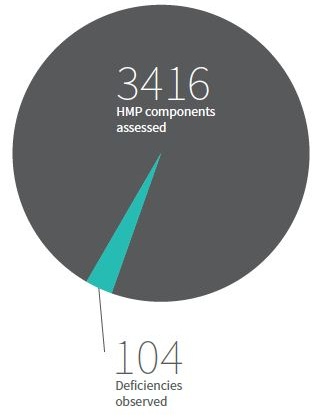
Figure 9. 2011 DFO Fish Health Management Plan Inspections at Salmon Aquaculture Facilities in B.C. - Table version
| Number of HMP components assessed | 3416 |
| Number of deficiencies observed | 104 |
Deficiencies observed
- Carcass retrieval protocol or record keeping needs improvement - 10
- Disease contingency or mass mortality information or records needs improvement - 2
- Fish handling, euthanasia protocol or records - 3
- Husbandry or record keeping as per COL needs improvement - 9
- Lice protocol or lice records as per COL improvement - 22
- Mooring signage needs improvement - 22
- Nutritional or medicated feed protocol concerns - 2
- Transfer records are not complete or up-to-date - 25
- Visitor protocol communication needs improvement - 7
- Water quality monitoring, equipment or record keeping needs improvement - 2
Fish health in 2012
Figure 10 summarizes the results of the Fish Health Management Plan inspections by DFO in 2012. A total of 118 HMP inspections were completed. During 77 of those visits, no deficiencies were observed. Of the 4,201 HMP components assessed during the inspections, 70 deficiencies were observed.
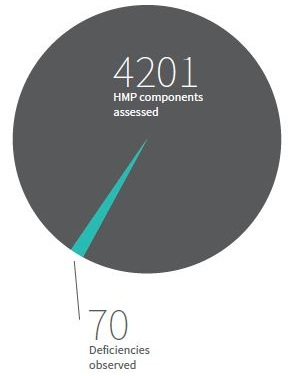
Figure 10. 2012 DFO Fish Health Management Plan Inspections at Salmon Aquaculture Facilities in B.C. - Table version
| Number of HMP components assessed | 4201 |
| Number of deficiencies observed | 70 |
Deficiencies observed
- Carcass retrieval protocol or record keeping needs improvement - 10
- Current licence was not posted at facility - 1
- Disease contingency or mass mortality information or records needs improvement - 1
- Fish handling, euthanasia protocol or records - 1
- Footbaths or sanitizers needs improvement - 1
- Husbandry or record keeping as per COL needs improvement - 8
- Lice protocol or lice records as per COL Appendix VI or VI-A needs improvement - 16
- Mooring signage needs improvement - 8
- Nutritional or medicated feed protocol concerns - 1
- Training documentation is not up-to-date - 6
- Transfer records are not complete or up-to-date - 11
- Visitor protocol communication needs improvement - 3
- Water quality monitoring, equipment or record keeping needs improvement - 2
- Wild fish mortality records need clarification - 1
Fish Health in 2013
Figure 11 summarizes the results of the Fish Health Management Plan inspections by DFO in 2013. A total of 120 HMP inspections were completed. During 83 of those visits, no deficiencies were observed. Of the 3,705 HMP components assessed during the inspections, 60 deficiencies were observed.
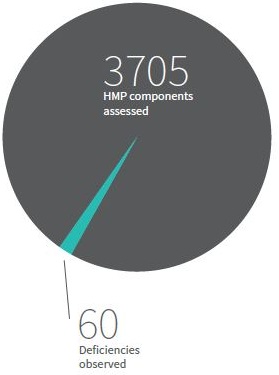
Figure 11. 2013 DFO Fish Health Management Plan Inspections at Salmon Aquaculture Facilities in B.C. - Table version
| Number of HMP components assessed | 3705 |
| Number of deficiencies observed | 60 |
Deficiencies Observed
- Carcass retrieval protocol or record keeping needs improvement - 4
- Current licence was not posted at facility - 2
- Footbaths or sanitizers needs improvement - 3
- Husbandry or record keeping as per COL needs improvement - 10
- Lice protocol or lice records as per COL Appendix VI or VI-A needs improvement - 15
- Mooring signage needs improvement - 7
- Nutritional or medicated feed protocol concerns - 3
- Transfer records are not complete or up-to-date 10
- Visitor protocol communication needs improvement - 4
- Water quality monitoring, equipment or record keeping needs improvement - 1
- Wild fish mortality records need clarification - 1
Fish Health in 2014
Figure 12 summarizes the results of the Fish Health Management Plan inspections by DFO in 2014. A total of 114 HMP inspections were completed. During 70 of those visits, no deficiencies were observed. Of the 2,928 HMP components assessed during the inspections, 60 deficiencies were observed.
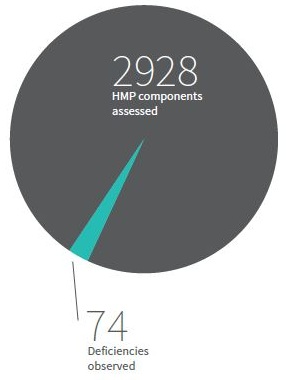
Figure 12. 2014 DFO Fish Health Management Plan Inspections at Salmon Aquaculture Facilities in B.C. - Table version
| Number of HMP components assessed | 2928 |
| Number of deficiencies observed | 74 |
Deficiencies Observed
- Carcass retrieval protocol or record keeping needs improvement - 23
- Footbaths or sanitizers needs improvement - 11
- Husbandry or record keeping as per COL needs improvement - 3
- Lice protocol or lice records as per COL Appendix VI or VI-A needs improvement - 19
- Mooring signage needs improvement - 6
- Nutritional or medicated feed protocol concerns - 1
- Training documentation is not up-to-date - 5
- Transfer records are not complete or up-to date - 4
- Visitor protocol communication needs improvement - 2
Sea Lice
Licence holders must count sea lice at active marine finfish facilities throughout the year: monthly from July 1 to February 28, and every two weeks from March 1 to June 30 when wild salmon smolts out-migrate. If the average number of motile Lepeophtheirus salmonis (a species of sea lice) exceeds three per fish, the licence holder must report the finding to DFO within seven days.
DFO performs their own sea lice counts at selected active Atlantic salmon farms to assess industry’s sea lice counting procedures. DFO also audits records to verify the accuracy of industry reporting.
At certain times, counting sea lice may be risky or harmful to farmed fish because some natural phenomena, including algal blooms and low dissolved oxygen (hypoxia), can stress or kill finfish. During these, handling of farmed fish to perform sea lice counts is curtailed.
Although various species and life stages of lice are counted, management actions are only required when the motile Lepeophtheirus salmonis threshold has been exceeded at a farm. The chart below illustrates the percentage of sites where the average number of motile Lepeophtheirus salmonis lice per fish exceeded the threshold, as reported by industry and through DFO’s own sea lice audits.
Figure 13 summarizes the sea lice counts performed by industry and DFO. In 2012, sea lice monitoring requirements in B.C. were suspended following an outbreak of infectious hematopoietic necrosis (IHN). Between 2011 and 2014, during the wild salmon outmigration period from March 1 to June 30, an average of 96% of sites were below the sea lice thresholds of three lice per fish.
More detailed monitoring results can be found on the DFO’s website.
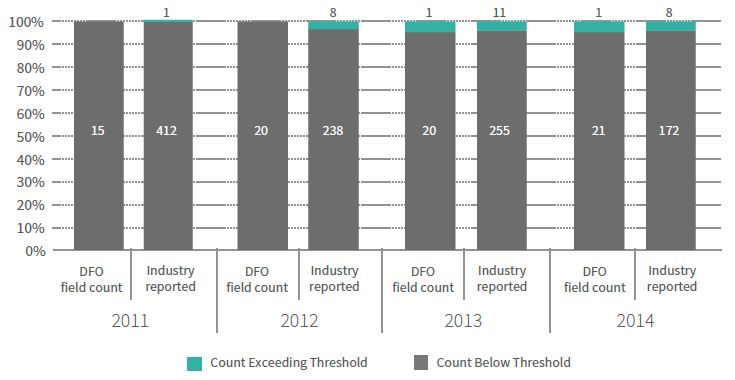
Figure 13. Counts of Motile Sea Lice Lepeophtheirus salmonis between March and June, 2011–2014 - Table version
| 2011 | 2012 | 2013 | 2014 | |||||
| DFO field count | Industry reported | DFO field count | Industry reported | DFO field count | Industry reported | DFO field count | Industry reported | |
| Count Exceeding Threshold | 0 | 1 | 0 | 8 | 1 | 11 | 1 | 8 |
| Count Below Threshold | 15 | 412 | 20 | 238 | 20 | 255 | 21 | 172 |
Fish Mortality
Licence holders are required to report on the numbers and causes of fish deaths at aquaculture facilities. Low levels of mortality normally occur in any large population of animals. A Mortality by Cause report describes the number and causes of all fish deaths (wild or cultured) at the facility and must be submitted quarterly to DFO. This report also states any therapeutants and anaesthetics used to treat the cultured fish during that quarter.
The licence holder must send an Urgent Notification to DFO within 24 hours of discovering a "major mortality event" as defined by the licence conditions. This notification provides as much detail as possible to DFO about the nature and extent of the event. After the Urgent Notification, a detailed report with information on the total weight of dead fish, number of dead fish, and percentage of the population lost must be submitted within ten days. For events that persist, update reports must be submitted every ten days until the mortality levels return to normal.
From 2011 to 2014, the most common causes of mortality events were harmful algal blooms and low dissolved oxygen. During this time, 42 reported mortality events were attributed to those causes. During the same period, other causes such as infectious disease, non-infectious disease, bacterial disease, and maturation accounted for 11 more mortality events.
Table 5 summarizes the total number of Fish Health Events notifications received by DFO from 2011 to 2014. For detailed information on mortality by cause and mortality events submitted by industry and from DFO audits, please visit: How DFO assesses the performance of aquaculture facilities.
- Date modified: